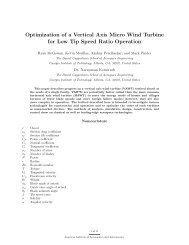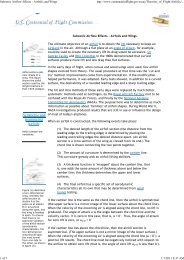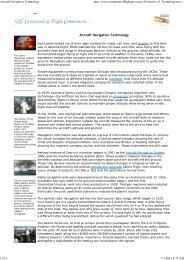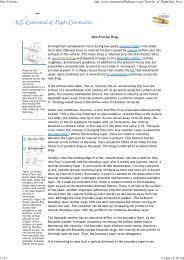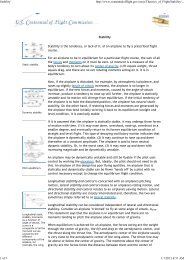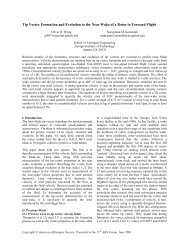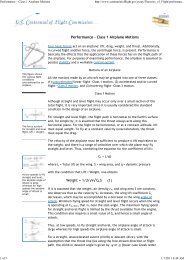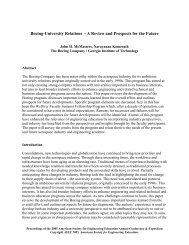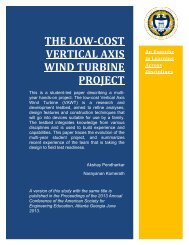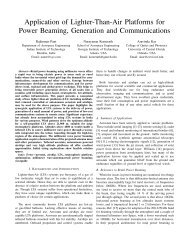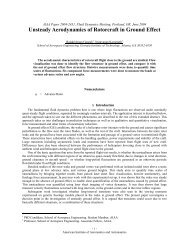p density of fluid, kg/m3 [Greek letter rho] V mean velocity of fluid, m ...
p density of fluid, kg/m3 [Greek letter rho] V mean velocity of fluid, m ...
p density of fluid, kg/m3 [Greek letter rho] V mean velocity of fluid, m ...
Create successful ePaper yourself
Turn your PDF publications into a flip-book with our unique Google optimized e-Paper software.
Real_Fluid_Flowhttp://www.centennial<strong>of</strong>flight.gov/essay/Theories_<strong>of</strong>_Flight/Real_Flui...1 <strong>of</strong> 3 1/1/2011 8:33 AMReal Fluid FlowThere are two different types <strong>of</strong> real <strong>fluid</strong> flow: laminar and turbulent. Inlaminar flow, the <strong>fluid</strong> moves in layers called laminas. Laminar flow need not bein a straight line. For laminar flow, the flow follows the curved surface <strong>of</strong> theairfoil smoothly, in layers. The closer the <strong>fluid</strong> layers are to the airfoil surface,the slower they move. Moreover, the <strong>fluid</strong> layers slide over one another without<strong>fluid</strong> being exchanged between the layers.Laminar andturbulent flow.Dependence <strong>of</strong> flowon Reynoldsnumber.In turbulent flow, secondary random motions are superimposed on the principalflow and there is an exchange <strong>of</strong> <strong>fluid</strong> from one adjacent sector to another.More importantly, there is an exchange <strong>of</strong> momentum such that slow moving<strong>fluid</strong> particles speed up and fast moving particles give up their momentum tothe slower moving particles and slow down themselves.Another example <strong>of</strong> a common occurrence <strong>of</strong> laminar and turbulent flow is thewater faucet. Opened slightly, at low speeds the water flows out in a clearcolumn—an instance <strong>of</strong> laminar flow. But open the faucet fully and the waterspeeds out in a cloudy turbulent column. In a mountain brook, the water mayslide over smooth rocks in laminas. In the Colorado River after the snow hasmelted, the flow churns downstream in confused, turbulent rapids. It will beseen that the flow over airfoil surfaces may assume both a laminar andturbulent characteristic depending upon a number <strong>of</strong> factors.In some cases, turbulent flow will appear "naturally" in a laminar flow as insmoke rising in the air. In other cases, by causing a disturbance, a laminar flowcan be changed to a turbulent flow. The question arises as to how one can tellwhether a flow is to be laminar or turbulent. In 1883, Osborne Reynoldsintroduced a dimensionless parameter that gave a quantitative indication <strong>of</strong> thelaminar to turbulent transition.In an experiment, Reynolds demonstrated that, under certain circumstances,the flow in a tube changes from laminar to turbulent over a given region <strong>of</strong> thetube. He used a large water tank that had a long tube outlet with a stopcock atthe end <strong>of</strong> the tube to control the flow speed. The tube went smoothly into thetank. A thin filament <strong>of</strong> colored <strong>fluid</strong> was injected into the flow at the mouth.Surface roughnessand flow field. Allcases have thesame Reynoldsnumber.When the speed <strong>of</strong> the water flowing through the tube was low, the filament <strong>of</strong>colored <strong>fluid</strong> maintained its identity for the entire length <strong>of</strong> the tube. However,when the flow speed was high, the filament broke up into the turbulent flowthat existed through the cross section.Reynolds defined a dimensionless parameter, which has since been known as theReynolds number, to give a quantitative description <strong>of</strong> the flow. In equationform, the Reynolds number R iswherepV<strong>density</strong> <strong>of</strong> <strong>fluid</strong>, <strong>kg</strong>/m 3 [<strong>Greek</strong> <strong>letter</strong> <strong>rho</strong>]<strong>mean</strong> <strong>velocity</strong> <strong>of</strong> <strong>fluid</strong>, m/sec
Real_Fluid_Flowhttp://www.centennial<strong>of</strong>flight.gov/essay/Theories_<strong>of</strong>_Flight/Real_Flui...2 <strong>of</strong> 3 1/1/2011 8:33 AMd characteristic length, mµ coefficient <strong>of</strong> viscosity, <strong>kg</strong>/m-secFor this setup, Reynolds found, by using water, that below R = 2,100, the flow inthe pipe was laminar as evidenced by the distinct colored filament. This valuewas true regardless <strong>of</strong> the varying combinations <strong>of</strong> values <strong>of</strong> p, V, d, or µ. Atransition between laminar and turbulent flow occurred for Reynolds numbersbetween 2,100 and 40,000 depending upon how smooth the tube junction wasand how carefully the flow entered the tube. Above R = 40,000, the flow wasalways turbulent, as evidenced by the colored <strong>fluid</strong> filament breaking upquickly. The fact that the transition Reynolds number (between 2,100 and40,000) was variable indicates the effect that induced turbulence has on theflow.The numerical values given for the transition are for this particular experimentsince the characteristic length chosen, d, is the diameter <strong>of</strong> the pipe. For anairfoil, d would be the distance between the leading and trailing edge called thechord length. Additionally, water was used in the Reynolds experiment whereasair flows about an airfoil. Thus, the transition number between laminar andturbulent flow would be far different for the case <strong>of</strong> an airfoil. Typically, airfoilsoperate at Reynolds numbers <strong>of</strong> several million. The general trend, however, isevident. For a particular body, low Reynolds number flows are laminar and highReynolds number flows are mostly turbulent.The Reynolds number may be viewed another way:The viscous forces arise because <strong>of</strong> the internal friction <strong>of</strong> the <strong>fluid</strong>. The inertiaforces represent the <strong>fluid</strong>'s natural resistance to acceleration. In a low Reynoldsnumber flow, the inertia forces are negligible compared with the viscous forces,whereas in a high Reynolds number flow, the viscous forces are small relative tothe inertia forces. An example <strong>of</strong> a low Reynolds number flow (called Stoke'sflow) is a small steel ball dropped into a container <strong>of</strong> heavy silicon oil. The ballfalls slowly through the liquid; viscous forces are large. Dust particles settlingthrough the air are another case <strong>of</strong> a low Reynolds number flow. These flows arelaminar. In a high Reynolds number flow, such as typically experienced in theflight <strong>of</strong> aircraft, both laminar and turbulent flows are present.Surface roughness also affects a body immersed in a flow field. Surfaceroughness causes the flow near the body to go from laminar to turbulent. As thesurface roughness increases, the first occurrence <strong>of</strong> turbulent flow will moveagainst the direction <strong>of</strong> the flow along the airfoil. The Reynolds number andsurface roughness are not independent <strong>of</strong> each other and both contribute to thedetermination <strong>of</strong> the laminar to turbulent transition. A very low Reynoldsnumber flow will be laminar even on a rough surface and a very high Reynoldsnumber flow will be turbulent even though the surface <strong>of</strong> a body is highlypolished.Another important factor in the transition from laminar to turbulent flow is thepressure gradient in the flow field. If the static pressure increases withdownstream distance, disturbances in a laminar flow will be amplified andturbulent flow will result. If the static pressure decreases as distance in thedirection <strong>of</strong> the airflow increases, disturbances in a laminar flow will damp out(or decrease) and the flow will tend to remain laminar. Over an airfoil, thestatic pressure decreases up to the point <strong>of</strong> maximum thickness. A laminar flow
Real_Fluid_Flowhttp://www.centennial<strong>of</strong>flight.gov/essay/Theories_<strong>of</strong>_Flight/Real_Flui...3 <strong>of</strong> 3 1/1/2011 8:33 AMwill be encouraged in this region. Beyond the point <strong>of</strong> maximum thickness (orshoulder <strong>of</strong> the airfoil), the static pressure increases. The laminar flow now ishindered and may go turbulent before reaching the trailing edge.—Adapted from Talay, Theodore A. Introduction to the Aerodynamics <strong>of</strong>Flight. SP-367, Scientific and Technical Information Office, NationalAeronautics and Space Administration, Washington, D.C. 1975. Available athttp://history.nasa.gov/SP-367/cover367.htmFor Further Reading:Anderson, Jr., John D. A History <strong>of</strong> Aerodynamics. Cambridge, England:Cambridge University Press, 1997.Wegener, Peter P. What Makes Airplanes Fly? New York: Springer-Verlag,1991.EducationalOrganizationInternationalTechnology EducationAssociationNational Council <strong>of</strong>Teachers <strong>of</strong>MathematicsNational ScienceEducation StandardsNational ScienceEducation StandardsStandard Designation(where applicableStandard 2N/AContent Standard AContent Standard BContent <strong>of</strong> StandardStudents will develop anunderstanding <strong>of</strong> the coreconcepts <strong>of</strong> technology.Instructional programsfrom pre-kindergartenthrough grade 12 shouldenable all students tounderstand numbers,ways <strong>of</strong> representingnumbers, relationshipsamong numbers, andnumber systems.As a result <strong>of</strong> activities ingrades 9-12, all studentsshould developunderstandings aboutscientific inquiry.As a result <strong>of</strong> activities ingrades 9-12, all studentsshould develop anunderstanding <strong>of</strong> motionsand forces.Home | About Us | Calendar | Wright Brothers History | History <strong>of</strong> Flight | Sights & Sounds | Licensed Products | Education | Links | Sitemap


![p density of fluid, kg/m3 [Greek letter rho] V mean velocity of fluid, m ...](https://img.yumpu.com/50595898/1/500x640/p-density-of-fluid-kg-m3-greek-letter-rho-v-mean-velocity-of-fluid-m-.jpg)
